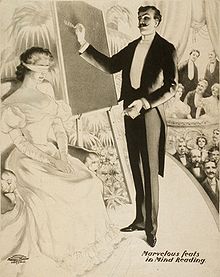Types of magic performance
- Stage illusions are performed for large audiences, typically within an auditorium. This type of magic is distinguished by large-scale props, the use of assistants and often exotic animals such as elephants and tigers. Some famous stage illusionists, past and present, include Harry Blackstone, Sr., Howard Thurston, Chung Ling Soo, David Copperfield, Siegfried & Roy, and Harry Blackstone, Jr..
- Platform magic (also known as cabaret magic or stand-up magic) is performed for a medium to large audience. Nightclub magic and comedy club magic are also examples of this form. The use of illusionettes (small tabletop illusions) is common. The term parlor magic is sometimes used but is considered by some to be pejorative. This genre includes the skilled manipulation of props such as billiard balls, card fans, doves, rabbits, silks, and rope. Examples of such magicians include Jeff McBride, Penn & Teller, David Abbott, Channing Pollock, Black Herman, and Fred Kaps.
- Micromagic (also known as close-up magic or table magic) is performed with the audience close to the magician, sometimes even one-on-one. It usually makes use of everyday items as props, such as cards (see Card manipulation), coins (see Coin magic), and seemingly 'impromptu' effects. This may be called "table magic", particularly when performed as dinner entertainment. Ricky Jay and Lee Asher, following in the traditions of Dai Vernon, Slydini, and Max Malini, are considered among the foremost practitioners of close-up magic.
- Escapology is the branch of magic that deals with escapes from confinment or restraints. Harry Houdini is a well-known example of an escape artist or escapologist.
- Mentalism creates the impression in the minds of the audience that the performer possesses special powers to read thoughts, predict events, control other minds, and similar feats. It can be presented on a stage, in a cabaret setting, before small close-up groups, or even for one spectator. Well-known mentalists of the past and present include Alexander, The Zancigs, Axel Hellstrom, Dunninger, Kreskin, Derren Brown, Guy Bavli and Banachek.
- Theatrical séances simulate spiritualistic or mediumistic phenomena for theatrical effect. This genre of stage magic has been misused at times by charlatans pretending to actually be in contact with spirits.
- Children's magic is performed for an audience primarily composed of children. It is typically performed at birthday parties, preschools, elementary schools, Sunday schools or libraries. This type of magic is usually comedic in nature and involves audience interaction as well as volunteer assistants.
- Online magic tricks were designed to function on a computer screen. The computer essentially replaces the magician. Some online magic tricks recreate traditional card tricks and require user participation, while others, like Plato's Cursed Triangle, are based on mathematical, geometrical and/or optical illusions. One such online magic trick, called Esmeralda's Crystal Ball, became a viral phenomenon that fooled so many computer users into believing that their computer had supernatural powers, that Snopes dedicated a page to debunking the trick.
- Mathemagic is a genre of stage magic that combines magic and mathematics. It is commonly used by children's magicians and mentalists.
- Corporate magic or trade show magic uses magic as a communication and sales tool, as opposed to just straightforward entertainment. Corporate magicians may come from a business background and typically present at meetings, conferences and product launches. They run workshops and can sometimes be found at trade shows, where their patter and illusions enhance an entertaining presentation of the products offered by their corporate sponsors. Pioneer performers in this arena include Eddie Tullock and Guy Bavli.
- Gospel magic uses magic to catechize and evangelize. Gospel magic was first used by St. Don BoscoTurin, Italy to come back to school, to accept assistance and to attend church. to interest children in 19th century
- Street magic is a form of street performing or busking that employs a hybrid of stage magic, platform and close-up magic, usually performed 'in the round' or surrounded by the audience. Notable modern street magic performers include Jeff Sheridan and Gazzo. Since the first David Blaine TV special Street Magic aired in 1997, the term "street magic" has also come to describe a style of 'guerilla' performance in which magicians approach and perform for unsuspecting members of the public on the street. Unlike traditional street magic, this style is almost purely designed for TV and gains its impact from the wild reactions of the public. Magicians of this type include David Blaine and Cyril Takayama.
- Bizarre magic uses mystical, horror, fantasy and other similar themes in performance. Bizarre magic is typically performed in a close-up venue, although some performers have effectively presented it in a stage setting. Charles Cameron has generally been credited as the "godfather of bizarre magic." Others, such as Tony Andruzzi, have contributed significantly to its development.
- Shock magic is a genre of magic that shocks the audience. Sometimes referred to as "geek magic," it takes its roots from circus sideshows, in which 'freakish' performances were shown to audiences. Common shock magic or geek magic effects include eating razor blades, needle-through-arm, string through neck and pen-through-tongue.


